If your business sends a lot of emails it’s very important that you track your email marketing after completing the initial set up.
WARNING: Before setting up email tracking PLEASE ensure that your funnel is being tracked correctly and the Hyros Universal script is on all of your pages.
Email Tracking Setup
Please select the dropdown depending on the specific email / messaging automation software you are using to setup tracking:
Step 1 – Setup UTM Tracking in Active Campaign
Following Active Campaign’s documentation, setup Google analytics UTM tracking in the advanced settings as shown here:

This will automatically add standard UTMs to any newly created campaigns moving forward. Specifically for the purposes of Hyros tracking, these 2 UTMs are the most important:
utm_sourceutm_campaign
Hyros will use these UTMs to create a source using a URL rule created in the next step.
Adding UTMs to retroactive campaigns
Please take in mind that previous email campaigns will not have Google Analytics UTM tracking enabled when you complete the above steps, this will only apply to new campaigns.
If you want to track old campaigns with Hyros, then please ensure that Google analytics is turned on at campaign level for these pre-existing campaigns by following these steps:
- Click Campaigns on the left menu.
- Locate the campaign you wish to update.
- Navigate to the Campaign Summary page.
- Click the Google Analytics toggle to set it to the “On” position.
- A modal window will appear and display the name of your campaign in the “Google Analytics Campaign Name” field. If you’d like to change the name, you can type it into the field provided. This name appears in Google Analytics under the “Campaigns” tab of the Acquisition reports category.
- Click “Done.”
Step 2 – Add a URL rule inside Hyros
Follow the steps here to setup a dynamic URL rule to track whatever comes after utm_campaign as a source in Hyros, which means we’ll be tracking events back to the specific campaign they came from.
This will not effect other tracking such as ad tracking as long as you have already setup tracking correctly. For ad sources and other specific sources, we highly advise tracking them following their specific guides before proceeding with these steps:
1. Navigate to https://app.hyros.com/tracking/url-rules
You can also get there by clicking “Tracking” and then “URL Rules” in your Hyros account.

2. Click “Add new rule”.
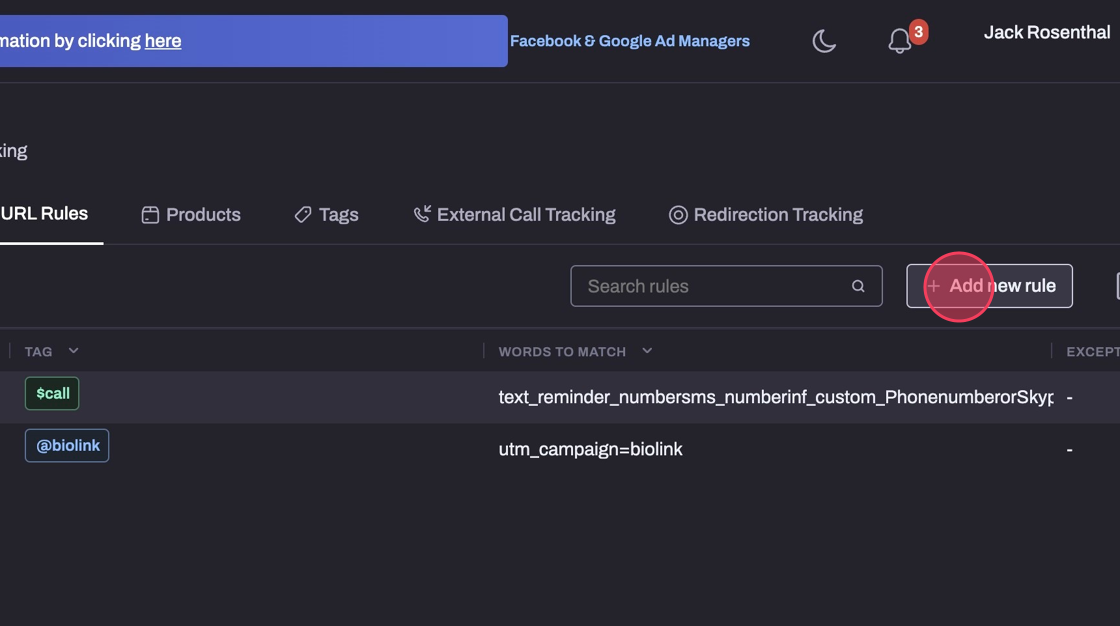
3. Click “Dynamic Rule”
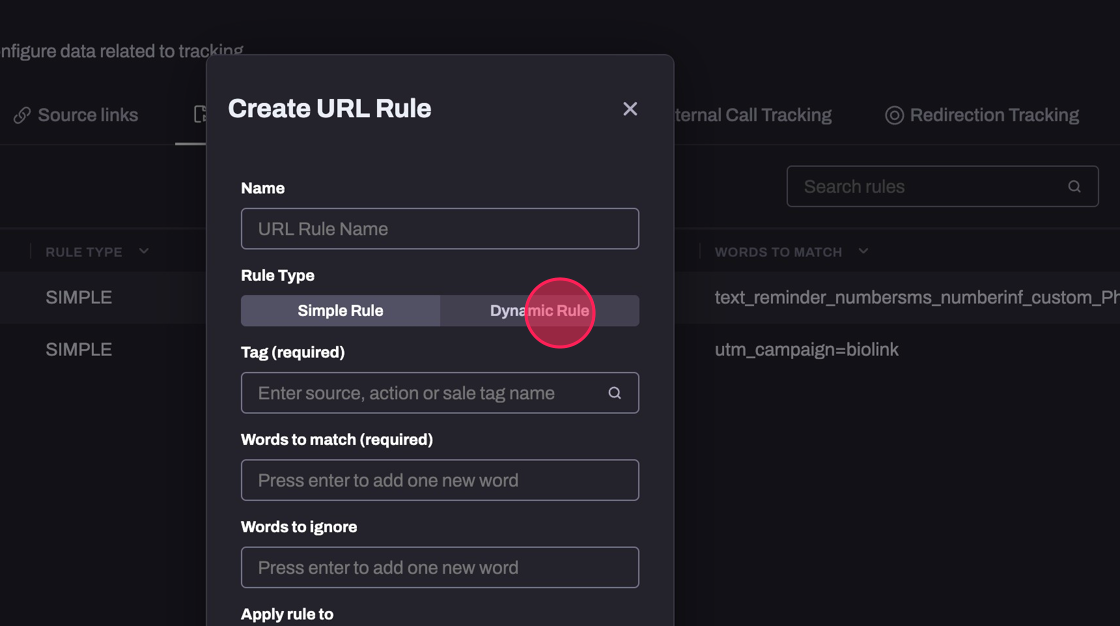
4. Click the “URL Rule Name” field.
Name it whatever makes sense to you, for example “Email” if you are trying to track email traffic.

5. Click the “URL parameter” field.
Using the standards UTM’s you have already setup, you can add the parameter you want to use to track a source.
For example, the most common case for email’s would be to type “utm_campaign” and click “enter”.
This will create a source based on whatever comes after “utm_campaign=” in the URL, which in the case of email will allow you to track back to specific email campaigns.
So for example if a lead clicks on an email campaign labelled “campaign1” then the URL they land on will be “www.hyros.com?utm_campaign=campaign1”
In this case Hyros will generate a source labelled “@campaign1”

6. Select the Tag type you want to generate. In the example of emails we want to generate a source.
If you are unsure what each tag does please consult the following guide https://docs.hyros.com/using-tags-to-track-customers/
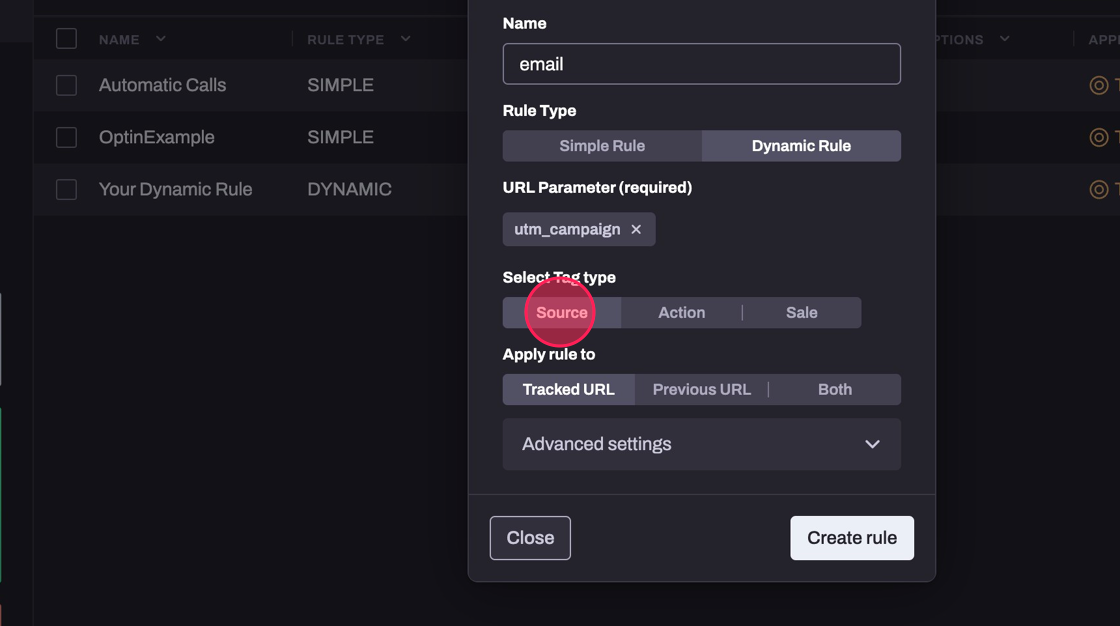
7. OPTIONAL STEP – Click “Advanced Settings”.

8. You will see by default under the “Dynamic Source Traffic Parameter” we are using “utm_source”.
This means when we first create a brand new source using this rule, if the “utm_source” exists in the same click we will use this to organize this source into a traffic source automatically.
Please change this as necessary depending on your unique UTM setup.

9. You can do exactly the same in the “Dynamic Source Category Parameter” to automatically configure the category of any newly created sources using this rule, although this is not necessary.
For more information on how traffic sources and source categories work in Hyros to organize your data, please see https://docs.hyros.com/organizing-mass-data/

10. Click “Create rule”.
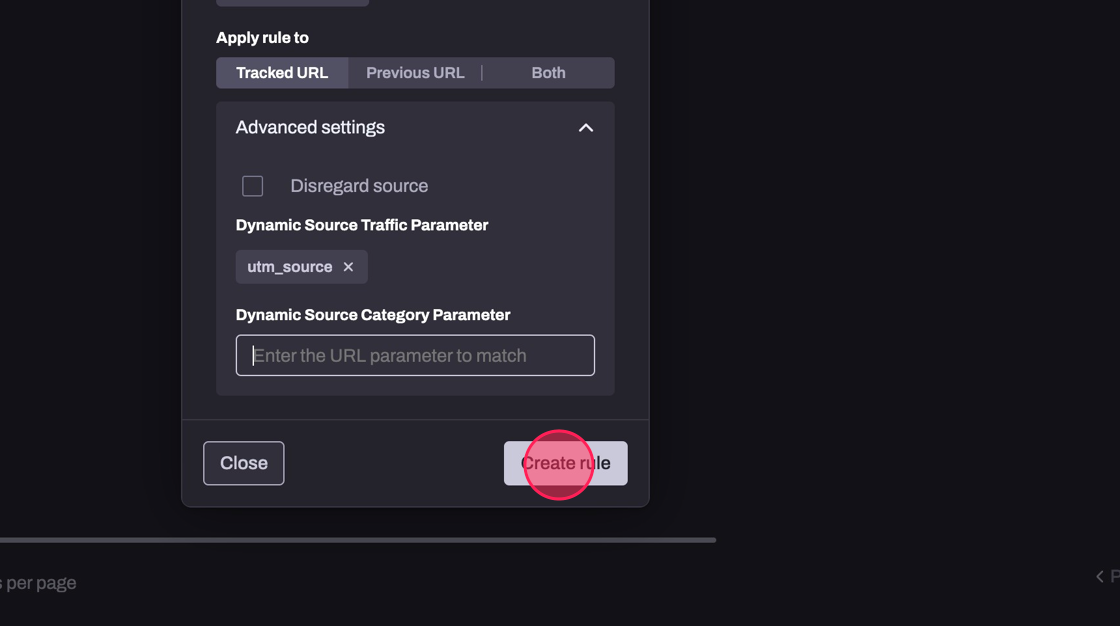
This will conclude the setup, however please proceed to the next step if you want to optimize tracking by passing on the lead email.
Step 3 – Add the lead email to the URL (Optional step)
This step is optional as tracking the source click is already done by the URL rule you setup in the previous step.
If you decide you don’t need to do this, please move to step 4 to test your email tracking.
What does this do?
This step is used to optimize tracking by passing on the lead email when they click on a call to action link in one of your emails.
The reason this might be needed, is although Hyros is very effective at tracking leads across multiple devices over a long time period, there may be some rare cases as described here that cause attribution to fail:
If you’d like to set this up for optimized tracking please see the below:
Adding the parameter
Please copy the following code for Active Campaign:
?he=%EMAIL%
Unfortunately Active Campaign does not allow you to add the above UTM globally, because they don’t have an option to add the dynamic %EMAIL% code to the global settings, nor do they allow you to do this at campaign level.
Therefore the only way to add this is directly on the call to action link itself on each of your emails.
So for example if your call to action link is the following:
www.yourlandingpage.com
Then add the above parameter manually to the end of the link like this:
www.yourlandingpage.com?he=%EMAIL%
Step 4 – Test your Campaign or Flow
Following Active Campign’s guide send yourself a test email. Please ensure you send an email rather than just viewing a preview, as the UTMs will not display correctly in a preview.
Click on the call to action link and find the URL. You should see the standard UTMs attached cleanly in the URL like this:
www.yourlandingpage.com?utm_source=email&utm_campaign=emailcampaignname
If you have added the “he” UTM parameter following step 3, you should also see that included in the URL with the email clearly attached like this:
www.yourlandingpage.com?he=johndoe@hyros.com&utm_source=email&utm_campaign=emailcampaignname
Please take in mind some email softwares won’t display the dynamic data as expected in test emails, so you may see slightly different information than you were expecting. The important thing is that the UTMs are present and cleanly attached to the end of the URL.
Go through the funnel and opt in, book a call or checkout as if you were a lead.
After waiting a few minutes you should be able to find your tracked email under sales data -> leads. Click on the email and you should see the email source attached:

If you see this tracking has been successful!
If you do not see this , please follow the troubleshooting steps below:
If you don’t see your email
- If you haven’t done so yet, make sure you follow the funnel steps and submit and email.
- Make sure the universal script is added to all your pages, including on the page where you entered your email (such as the opt in or checkout page).
If you see the email but no @source tag in the journey
- Check the UTMs are being passed on correctly to the URL after clicking on an email link.
- Ensure the URL rule you setup in step 2 is added correctly. Check for typos in the “URL parameter” field, it must match exactly with the UTM in the URL.
- Ensure the landing page has the Hyros Universal script attached
Step 1 – Setup UTM Tracking in Drip
Following Braze’s documentation, setup your default campaign parameters in the UTM tracking settings.
Specifically for the purposes of Hyros tracking, it’s recommended to do the following.
Make sure you have utm_source and utm_campaign rows displayed as below.
- for utm_source type in braze
- for utm_campaign introduce {{campaign.${name}}}

This will add these UTMs to all of your campaigns and flows by default.
Step 2 – Add a URL rule inside Hyros
Follow the steps here to setup a dynamic URL rule to track whatever comes after utm_campaign as a source in Hyros, which means we’ll be tracking events back to the specific campaign they came from.
This will not effect other tracking such as ad tracking as long as you have already setup tracking correctly. For ad sources and other specific sources, we highly advise tracking them following their specific guides before proceeding with these steps.
This will conclude the setup, however please proceed to the next step if you want to optimize tracking by passing on the lead email.
Step 3 – Add the lead email to the URL (Optional step)
This step is optional as tracking the source click is already done by the URL rule you setup in the previous step.
If you decide you don’t need to do this, please move to step 4 to test your email tracking.
What does this do?
This step is used to optimize tracking by passing on the lead email when they click on a call to action link in one of your emails.
The reason this might be needed, is although Hyros is very effective at tracking leads across multiple devices over a long time period, there may be some rare cases as described here that cause attribution to fail:
If you’d like to set this up for optimized tracking please see the below:
Adding the parameter: he={{ email }}
Click the Add query parameter button below. The first field on the left should type in he, and the second field {{ email }}.
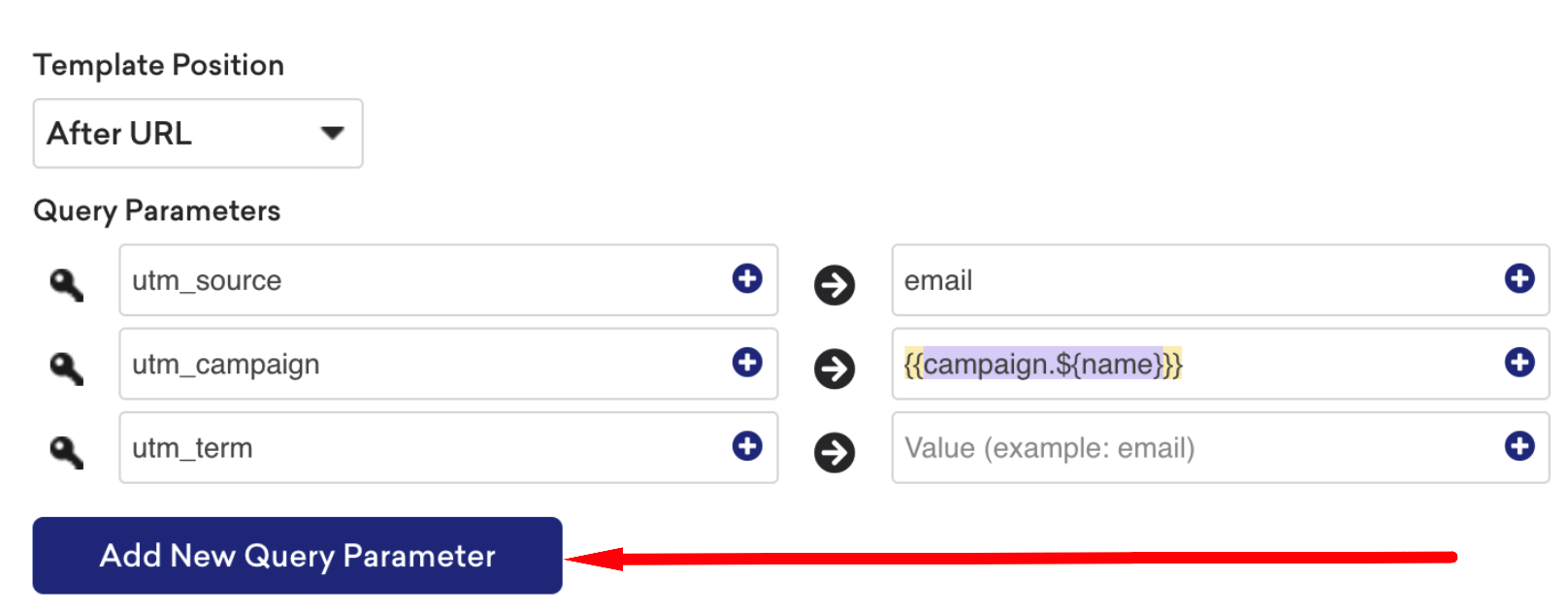
Step 4 – Test your Campaign or Flow
Following Klaviyo’s guides beflow send yourself a test email campaign or SMS.
Test your email campaigns here.
Click on the call to action link and find the URL. You should see the standard UTMs attached cleanly in the URL like this:
www.yourlandingpage.com?utm_source=email&utm_campaign=emailcampaignname
If you have added the “he” UTM parameter following step 3, you should also see that included in the URL with the email clearly attached like this:
www.yourlandingpage.com?he=johndoe@hyros.com&utm_source=email&utm_campaign=emailcampaignname
Please take in mind some email softwares won’t display the dynamic data as expected in test emails, so you may see slightly different information than you were expecting. The important thing is that the UTMs are present and cleanly attached to the end of the URL.
Go through the funnel and opt in, book a call or checkout as if you were a lead.
After waiting a few minutes you should be able to find your tracked email under sales data -> leads. Click on the email and you should see the email source attached:

If you see this tracking has been successful!
If you do not see this , please follow the troubleshooting steps below:
If you don’t see your email
- If you haven’t done so yet, make sure you follow the funnel steps and submit and email.
- Make sure the universal script is added to all your pages, including on the page where you entered your email (such as the opt in or checkout page).
If you see the email but no @source tag in the journey
- Check the UTMs are being passed on correctly to the URL after clicking on an email link.
- Ensure the URL rule you setup in step 2 is added correctly. Check for typos in the “URL parameter” field, it must match exactly with the UTM in the URL.
- Ensure the landing page has the Hyros Universal script attached
Step 1 – Setup UTM Tracking in Drip
Following Drips’s documentation, setup your default campaign parameters in the UTM tracking settings.
Specifically for the purposes of Hyros tracking, it’s recommended to do the following: go to Settings -> Email Setup -> Google Analytics.
Make sure you have drip as the name inside the Source field and that you have Campaign Name selected from the dropdown list, exactly as shown below:

This will add these UTMs to all of your campaigns and flows by default.
Step 2 – Add a URL rule inside Hyros
Follow the steps here to setup a dynamic URL rule to track whatever comes after utm_campaign as a source in Hyros, which means we’ll be tracking events back to the specific campaign they came from.
This will not effect other tracking such as ad tracking as long as you have already setup tracking correctly. For ad sources and other specific sources, we highly advise tracking them following their specific guides before proceeding with these steps:
1. Navigate to https://app.hyros.com/tracking/url-rules
You can also get there by clicking “Tracking” and then “URL Rules” in your Hyros account.

2. Click “Add new rule”.

3. Click “Dynamic Rule”

4. Click the “URL Rule Name” field.
Name it whatever makes sense to you, for example “Email” if you are trying to track email traffic.

5. Click the “URL parameter” field.
Using the standards UTM’s you have already setup, you can add the parameter you want to use to track a source.
For example, the most common case for email’s would be to type “utm_campaign” and click “enter”.
This will create a source based on whatever comes after “utm_campaign=” in the URL, which in the case of email will allow you to track back to specific email campaigns.
So for example if a lead clicks on an email campaign labelled “campaign1” then the URL they land on will be “www.hyros.com?utm_campaign=campaign1”
In this case Hyros will generate a source labelled “@campaign1”

6. Select the Tag type you want to generate. In the example of emails we want to generate a source.
If you are unsure what each tag does please consult the following guide https://docs.hyros.com/using-tags-to-track-customers/

7. OPTIONAL STEP – Click “Advanced Settings”.

8. You will see by default under the “Dynamic Source Traffic Parameter” we are using “utm_source”.
This means when we first create a brand new source using this rule, if the “utm_source” exists in the same click we will use this to organize this source into a traffic source automatically.
Please change this as necessary depending on your unique UTM setup.

9. You can do exactly the same in the “Dynamic Source Category Parameter” to automatically configure the category of any newly created sources using this rule, although this is not necessary.
For more information on how traffic sources and source categories work in Hyros to organize your data, please see https://docs.hyros.com/organizing-mass-data/

10. Click “Create rule”.

This will conclude the setup, however please proceed to the next step if you want to optimize tracking by passing on the lead email.
Step 3 – Add the lead email to the URL (Optional step)
This step is optional as tracking the source click is already done by the URL rule you setup in the previous step.
If you decide you don’t need to do this, please move to step 4 to test your email tracking.
What does this do?
This step is used to optimize tracking by passing on the lead email when they click on a call to action link in one of your emails.
The reason this might be needed, is although Hyros is very effective at tracking leads across multiple devices over a long time period, there may be some rare cases as described here that cause attribution to fail:
If you’d like to set this up for optimized tracking please see the below:
Adding the parameter
Please copy the following code for Klaviyo:
?he={{ email }}
Unfortunately Drip does not allow you to add the above UTM globally even as a custom UTM, because they don’t have an option to add the dynamic {{ email }} code to the global settings, nor do they allow you to do this at campaign or flow level to our knowledge.
Therefore the only way to add this is directly on the call to action link itself on each of your emails.
So for example if your call to action link is the following:
www.yourlandingpage.com
Then add the above parameter manually to the end of the link like this:
www.yourlandingpage.com?he={{ email }}
Step 4 – Test your Campaign or Flow
Following Klaviyo’s guides beflow send yourself a test email campaign or SMS.
Test your email campaigns here.
Click on the call to action link and find the URL. You should see the standard UTMs attached cleanly in the URL like this:
www.yourlandingpage.com?utm_source=email&utm_campaign=emailcampaignname
If you have added the “he” UTM parameter following step 3, you should also see that included in the URL with the email clearly attached like this:
www.yourlandingpage.com?he=johndoe@hyros.com&utm_source=email&utm_campaign=emailcampaignname
Please take in mind some email softwares won’t display the dynamic data as expected in test emails, so you may see slightly different information than you were expecting. The important thing is that the UTMs are present and cleanly attached to the end of the URL.
Go through the funnel and opt in, book a call or checkout as if you were a lead.
After waiting a few minutes you should be able to find your tracked email under sales data -> leads. Click on the email and you should see the email source attached:

If you see this tracking has been successful!
If you do not see this , please follow the troubleshooting steps below:
If you don’t see your email
- If you haven’t done so yet, make sure you follow the funnel steps and submit and email.
- Make sure the universal script is added to all your pages, including on the page where you entered your email (such as the opt in or checkout page).
If you see the email but no @source tag in the journey
- Check the UTMs are being passed on correctly to the URL after clicking on an email link.
- Ensure the URL rule you setup in step 2 is added correctly. Check for typos in the “URL parameter” field, it must match exactly with the UTM in the URL.
- Ensure the landing page has the Hyros Universal script attached
Step 1 – Setup UTM Tracking in Klaviyo
Following Klaviyo’s documentation, setup your default campaign parameters in the UTM tracking settings.
This can be done under settings -> other -> UTM Tracking.
Specifically for the purposes of Hyros tracking, it’s recommended to do the following:
- Activate
utm_source - Activate
utm_campaign - Toggle on “automatically add UTM parameters to links”
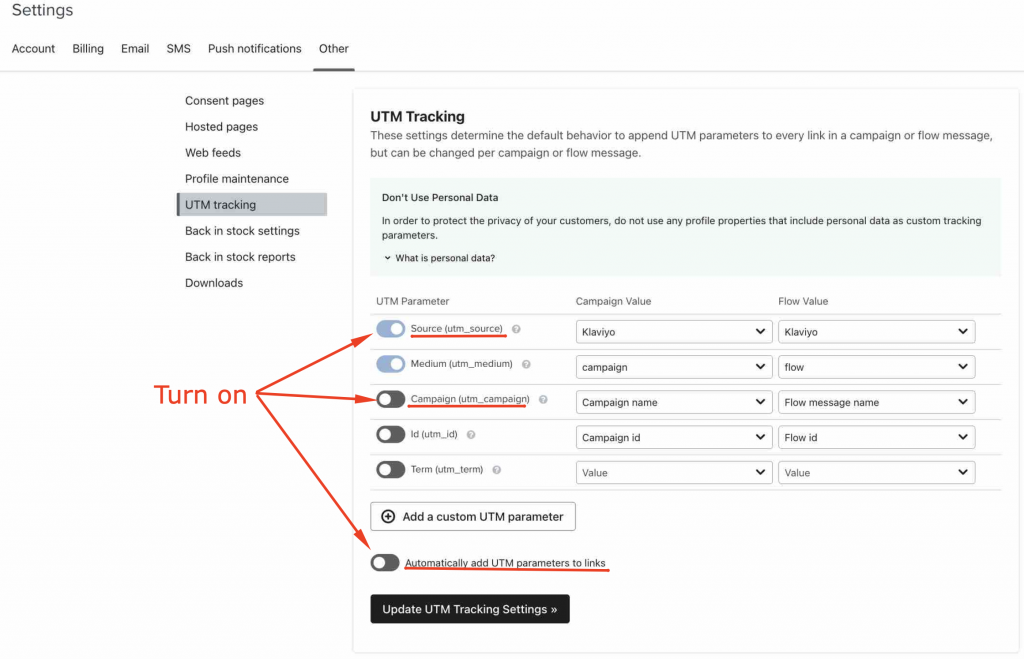
This will add these UTMs to all of your campaigns and flows by default.
Please take in mind though that if you have amended or disabled UTM tracking at campaign or flow level, then these global UTM settings will not be used.
It’s important to ensure that UTMs are added in a consistent manner in order for tracking to be consistent, so please check your campaign and flow settings following this guide from Klaviyo.
Step 2 – Add a URL rule inside Hyros
Follow the steps here to setup a dynamic URL rule to track whatever comes after utm_campaign as a source in Hyros, which means we’ll be tracking events back to the specific campaign they came from.
This will not effect other tracking such as ad tracking as long as you have already setup tracking correctly. For ad sources and other specific sources, we highly advise tracking them following their specific guides before proceeding with these steps:
1. Navigate to https://app.hyros.com/tracking/url-rules
You can also get there by clicking “Tracking” and then “URL Rules” in your Hyros account.

2. Click “Add new rule”.

3. Click “Dynamic Rule”

4. Click the “URL Rule Name” field.
Name it whatever makes sense to you, for example “Email” if you are trying to track email traffic.

5. Click the “URL parameter” field.
Using the standards UTM’s you have already setup, you can add the parameter you want to use to track a source.
For example, the most common case for email’s would be to type “utm_campaign” and click “enter”.
This will create a source based on whatever comes after “utm_campaign=” in the URL, which in the case of email will allow you to track back to specific email campaigns.
So for example if a lead clicks on an email campaign labelled “campaign1” then the URL they land on will be “www.hyros.com?utm_campaign=campaign1”
In this case Hyros will generate a source labelled “@campaign1”

6. Select the Tag type you want to generate. In the example of emails we want to generate a source.
If you are unsure what each tag does please consult the following guide https://docs.hyros.com/using-tags-to-track-customers/

7. OPTIONAL STEP – Click “Advanced Settings”.

8. You will see by default under the “Dynamic Source Traffic Parameter” we are using “utm_source”.
This means when we first create a brand new source using this rule, if the “utm_source” exists in the same click we will use this to organize this source into a traffic source automatically.
Please change this as necessary depending on your unique UTM setup.

9. You can do exactly the same in the “Dynamic Source Category Parameter” to automatically configure the category of any newly created sources using this rule, although this is not necessary.
For more information on how traffic sources and source categories work in Hyros to organize your data, please see https://docs.hyros.com/organizing-mass-data/

10. Click “Create rule”.

This will conclude the setup, however please proceed to the next step if you want to optimize tracking by passing on the lead email.
Step 3 – Add the lead email to the URL (Optional step)
This step is optional as tracking the source click is already done by the URL rule you setup in the previous step.
If you decide you don’t need to do this, please move to step 4 to test your email tracking.
What does this do?
This step is used to optimize tracking by passing on the lead email when they click on a call to action link in one of your emails.
The reason this might be needed, is although Hyros is very effective at tracking leads across multiple devices over a long time period, there may be some rare cases as described here that cause attribution to fail:
If you’d like to set this up for optimized tracking please see the below:
Adding the parameter
Please copy the following code for Klaviyo:
?he={{ email }}
Unfortunately Klaviyo does not allow you to add the above UTM globally even as a custom UTM, because they don’t have an option to add the dynamic {{ email }} code to the global settings, nor do they allow you to do this at campaign or flow level to our knowledge.
Therefore the only way to add this is directly on the call to action link itself on each of your emails.
So for example if your call to action link is the following:
www.yourlandingpage.com
Then add the above parameter manually to the end of the link like this:
www.yourlandingpage.com?he={{ email }}
Step 4 – Test your Campaign or Flow
Following Klaviyo’s guides beflow send yourself a test email campaign or SMS.
Test your email campaigns here.
Click on the call to action link and find the URL. You should see the standard UTMs attached cleanly in the URL like this:
www.yourlandingpage.com?utm_source=email&utm_campaign=emailcampaignname
If you have added the “he” UTM parameter following step 3, you should also see that included in the URL with the email clearly attached like this:
www.yourlandingpage.com?he=johndoe@hyros.com&utm_source=email&utm_campaign=emailcampaignname
Please take in mind some email softwares won’t display the dynamic data as expected in test emails, so you may see slightly different information than you were expecting. The important thing is that the UTMs are present and cleanly attached to the end of the URL.
Go through the funnel and opt in, book a call or checkout as if you were a lead.
After waiting a few minutes you should be able to find your tracked email under sales data -> leads. Click on the email and you should see the email source attached:

If you see this tracking has been successful!
If you do not see this , please follow the troubleshooting steps below:
If you don’t see your email
- If you haven’t done so yet, make sure you follow the funnel steps and submit and email.
- Make sure the universal script is added to all your pages, including on the page where you entered your email (such as the opt in or checkout page).
If you see the email but no @source tag in the journey
- Check the UTMs are being passed on correctly to the URL after clicking on an email link.
- Ensure the URL rule you setup in step 2 is added correctly. Check for typos in the “URL parameter” field, it must match exactly with the UTM in the URL.
- Ensure the landing page has the Hyros Universal script attached
Step 1 – Setup UTM Tracking in Active Campaign
Following Omnisend’s documentation here, ensure standard UTMs are added to your campaigns via the “UTM tags for Google Analytics Tracking” in the campaign settings:

You can do the same thing for automations by clicking on the specific message in the flow and finding the UTM settings here:

Specifically for the purposes of Hyros tracking, these 2 UTMs are the most important:
utm_sourceutm_campaign
Hyros will use these UTMs to create a source using a URL rule created in the next step. Note that you can use other UTMs if you wish, as long as one UTM consistently identifies the campaign or specific message in an automation.
You will then need to adjust the URL rule in the following step to use that specific UTM instead of the utm_campaign which is described in our guide.
So for example, if you are using utm_content to identify a specific message within an automation flow, and you want to track clicks based on the exact message, you can add utm_content as the words to match instead.
Please see the next step for more information.
Step 2 – Add a URL rule inside Hyros
Follow the steps here to setup a dynamic URL rule to track whatever comes after utm_campaign as a source in Hyros, which means we’ll be tracking events back to the specific campaign they came from.
This will not effect other tracking such as ad tracking as long as you have already setup tracking correctly. For ad sources and other specific sources, we highly advise tracking them following their specific guides before proceeding with these steps:
1. Navigate to https://app.hyros.com/tracking/url-rules
You can also get there by clicking “Tracking” and then “URL Rules” in your Hyros account.

2. Click “Add new rule”.

3. Click “Dynamic Rule”

4. Click the “URL Rule Name” field.
Name it whatever makes sense to you, for example “Email” if you are trying to track email traffic.

5. Click the “URL parameter” field.
Using the standards UTM’s you have already setup, you can add the parameter you want to use to track a source.
For example, the most common case for email’s would be to type “utm_campaign” and click “enter”.
This will create a source based on whatever comes after “utm_campaign=” in the URL, which in the case of email will allow you to track back to specific email campaigns.
So for example if a lead clicks on an email campaign labelled “campaign1” then the URL they land on will be “www.hyros.com?utm_campaign=campaign1”
In this case Hyros will generate a source labelled “@campaign1”

6. Select the Tag type you want to generate. In the example of emails we want to generate a source.
If you are unsure what each tag does please consult the following guide https://docs.hyros.com/using-tags-to-track-customers/

7. OPTIONAL STEP – Click “Advanced Settings”.

8. You will see by default under the “Dynamic Source Traffic Parameter” we are using “utm_source”.
This means when we first create a brand new source using this rule, if the “utm_source” exists in the same click we will use this to organize this source into a traffic source automatically.
Please change this as necessary depending on your unique UTM setup.

9. You can do exactly the same in the “Dynamic Source Category Parameter” to automatically configure the category of any newly created sources using this rule, although this is not necessary.
For more information on how traffic sources and source categories work in Hyros to organize your data, please see https://docs.hyros.com/organizing-mass-data/

10. Click “Create rule”.

This will conclude the setup, however please proceed to the next step if you want to optimize tracking by passing on the lead email.
Step 3 – Add the lead email to the URL (Optional step)
This step is optional as tracking the source click is already done by the URL rule you setup in the previous step.
If you decide you don’t need to do this, please move to step 4 to test your email tracking.
What does this do?
This step is used to optimize tracking by passing on the lead email when they click on a call to action link in one of your emails.
The reason this might be needed, is although Hyros is very effective at tracking leads across multiple devices over a long time period, there may be some rare cases as described here that cause attribution to fail:
If you’d like to set this up for optimized tracking please see the below:
Adding the parameter
Please copy the following code for Omnisend:
?he=[[contact.email]]
Unfortunately at the time of writing this, Omnisend does not allow you to add the above UTM parameter globally or at campaign/automation level.
Therefore the only way to add this is directly on the call to action link itself on each of your emails.
So for example if your call to action link is the following:
www.yourlandingpage.com
Then add the above parameter manually to the end of the link like this:
www.yourlandingpage.com?he=[[contact.email]]
Step 4 – Test your Campaign or Flow
Following Omnisend’s guide, send yourself a test email. Please ensure you send an email rather than just viewing a preview, as the UTMs will not display correctly in a preview.
Click on the call to action link and find the URL. You should see the standard UTMs attached cleanly in the URL like this:
www.yourlandingpage.com?utm_source=email&utm_campaign=emailcampaignname
If you have added the “he” UTM parameter following step 3, you should also see that included in the URL with the email clearly attached like this:
www.yourlandingpage.com?he=johndoe@hyros.com&utm_source=email&utm_campaign=emailcampaignname
Please take in mind some email softwares won’t display the dynamic data as expected in test emails, so you may see slightly different information than you were expecting. The important thing is that the UTMs are present and cleanly attached to the end of the URL.
Go through the funnel and opt in, book a call or checkout as if you were a lead.
After waiting a few minutes you should be able to find your tracked email under sales data -> leads. Click on the email and you should see the email source attached:

If you see this tracking has been successful!
If you do not see this , please follow the troubleshooting steps below:
If you don’t see your email
- If you haven’t done so yet, make sure you follow the funnel steps and submit and email.
- Make sure the universal script is added to all your pages, including on the page where you entered your email (such as the opt in or checkout page).
If you see the email but no @source tag in the journey
- Check the UTMs are being passed on correctly to the URL after clicking on an email link.
- Ensure the URL rule you setup in step 2 is added correctly. Check for typos in the “URL parameter” field, it must match exactly with the UTM in the URL.
- Ensure the landing page has the Hyros Universal script attached
Step 1: Place Our Email Parameter
Setting up email tracking in HYROS is simple. Just follow the steps below:
- Copy the parameter below depending on your email software that you are using, you can also find a list of email parameters in the tracking area HERE. Just click EMAIL TRACKING in the top right-hand corner.
- Paste this parameter at the end of any link in an email you send.
- Acuity:
?he=%email%&el=email - Campaign Refinery:
?he={{contact_email}}&el=email - CleverReach:
?he={email}&el=email - Drip:
?he={{ subscriber.email }}&el=email - Earnware:
?he=[email]&el=email - GetResponse:
?he=[[email]]&el=email - ConvertKit:
?he={{ subscriber.email_address }}&el=email - Mailchimp:
?he=*|EMAIL|*&el=email - Aweber:
?he={!email}&el=email - Infusionsoft/Keap:
?he=~Contact.Email~&el=email - Clickfunnels:
?he=#EMAIL#&el=email - Clickfunnels 2.0:
?he={{contact.email_address}}&el=email - Ontraport:
?he=[Email]&el=email - Everwebinar/Webinarjam:
?he={ATTENDEE_EMAIL}&el=email - GoHighLevel:
?he={{contact.email}}&el=email - HubSpot:
?he={{contact.email}}&el=email - Kartra:
?he={email}&el=email - Kajabi
?he={{email}}&el=email - MaroPost:
?he={{contact.email}}&el=email - Intercom:
?he={{email}}&el=email - Iterable:
?he={{email}}&el={{campaignName}} - SendGrid:
?he=[%email%]&el=email - SendLane:
?he=VAR_EMAIL&el=email - Sendy:
?he=[Email]&el=email - Smartemailing:
?he={{df_emailaddress}}&el=email - Lemlist:
?he={{email}}&el=email
EXAMPLE: If you are using Mailchimp you will place “?he=*|EMAIL|*&el=email” at the end of any link.
So if your link is “hyros.com” you would add the parameter to make “hyros.com?he=*|EMAIL|*&el=email“.
When a user clicks on the link inside their email, the email will dynamically populate inside the URL, for example, “hyros.com?he=useremail@example.com&el=email”
This email will then be tracked by our script, and the “email” in the “el=email” will create the @email tag and apply it to the user, therefore tracking the click as a source.
WHEN TESTING the email parameter attached will NOT work outside of the email. You must click on the link INSIDE an email from an inbox, otherwise there will not be an email to populate inside the URL, which will break tracking.
Want to track events back to a specific campaign?
By default we will track all email clicks under a single @email source tags, however if you want to track back to specific campaigns then just change what comes after el=.
For example instead of:
hyros.com?he=*|EMAIL|*&el=email
We would add this to signify the campaign is called “email campaign1”
hyros.com?he=*|EMAIL|*&el=emailcampaign1
This would generate a source labelled @emailcampaign1 inside Hyros.
Repeat this for each unique campaign.
Some email automation softwares will have a dynamic code to allow you to add the same code such as el={campaignname} to all of your links and generate the unique campaign name automatically.
Please consult with your email automation software support if this is something you would like to do.
Video Guide
NOTE: The video below shows a “hemail=” parameter being added to the link. This has recently been updated to “he=” which can be seen in the list of parameters above in step 1.
Step 2 – Test your Campaign or Flow
Send yourself a test email. Please ensure you send an email rather than just viewing a preview, as the UTMs will not display correctly in a preview.
Click on the call to action link and find the URL. You should see both the standard UTMs and the “he” email parameters attached cleanly in the URL like this:
www.yourlandingpage.com?he=johndoe@hyros.com&el=email
Please take in mind some email softwares won’t display the dynamic data as expected in test emails, so you may see slightly different information than you were expecting. The important thing is that the UTMs are present and cleanly attached to the end of the URL.
Go through the funnel and opt in, book a call or checkout as if you were a lead.
After waiting a few minutes you should be able to find your tracked email under sales data -> leads. Click on the email and you should see the email source attached:

If you see this tracking has been successful!
If you do not see this , please follow the troubleshooting steps below:
If you don’t see your email
- If you haven’t done so yet, make sure you follow the funnel steps and submit and email.
- Make sure the universal script is added to all your pages, including on the page where you entered your email (such as the opt in or checkout page).
- Please also check that the “he=” parameter generated the email correctly in the URL after clicking on the call to action link. If not please ensure there are no typos in the code, it’s also possible this is just because it was a test email, some email software’s will not display the correct email during tests.
If you see the email but no @source tag in the journey
- Check the “el=email” UTM parameter is passed on correctly to the URL after clicking on an email link.
- Ensure the landing page has the Hyros Universal script attached correctly.
FAQs
As you may have noticed, we have 2 different parameters which perform different functions that we advise adding to your email links:
For example, for active campaign these are: “?he=%EMAIL%&el=email”
Which can be split up into:
“he=%EMAIL%” AND
“el=email”
he=%EMAIL%
This will generate the email of the lead and add it to the landing page URL once they click on the link inside the email. So if the lead “example@hyros.com” clicks on your email link it will generate a URL such as “www.yourlandingpage.com?he=example@hyros.com“.
We use this to ensure we track that original email on the rare occasions that the lead comes back via email with totally different data points on a different device and then uses a different email.
So if they came back later in these circumstances and purchased using Hyros@Purchaseemail.com, we would be able to still track that email and therefore the purchase back to “example@hyros.com” and therefore continue their tracking profile from the original ad click.
This particular section is mostly useful for businesses with longer journeys. For e-commerce businesses or any business with a very short journey, this parameter is not totally necessary and can be removed.
See a video explanation for this specific parameter below:
el=email
This is the part of the parameter that actually creates the source. When we read the “el=email” parameter in the URL we will create an “@email” tag.
You can also change the name after “el=” to change the tag, so for example “el=emailcampaign1” will create a source named “@emailcampaign1”. This is useful if you want to track sales back to a specific email campaign.
If you have standard UTMs such as “utm_campaign” attached to all of your emails already, you don’t need to use this parameter. You can instead generate a dynamic URL rule following this guide to create a source based on this UTM, which will allow you track events back to a specific campaign automatically:
You often do NOT want to include email sources on reports because they will take credit for the last clicks on many sales. This will make your ads look like they are not performing since email will take all the credit.
It is also very hard to see the results of email marketing because ads will take a lot of credit as well. Mixing these two traffic sources together can be messy.
We solve this by letting you filter out ads or email/organic sources when viewing reports. Inside Hyros email is treated as an organic source by default.
You can use this filter to view both, just email or just ads. This will give you a much clearer view of how email and ads are working on their own and together.
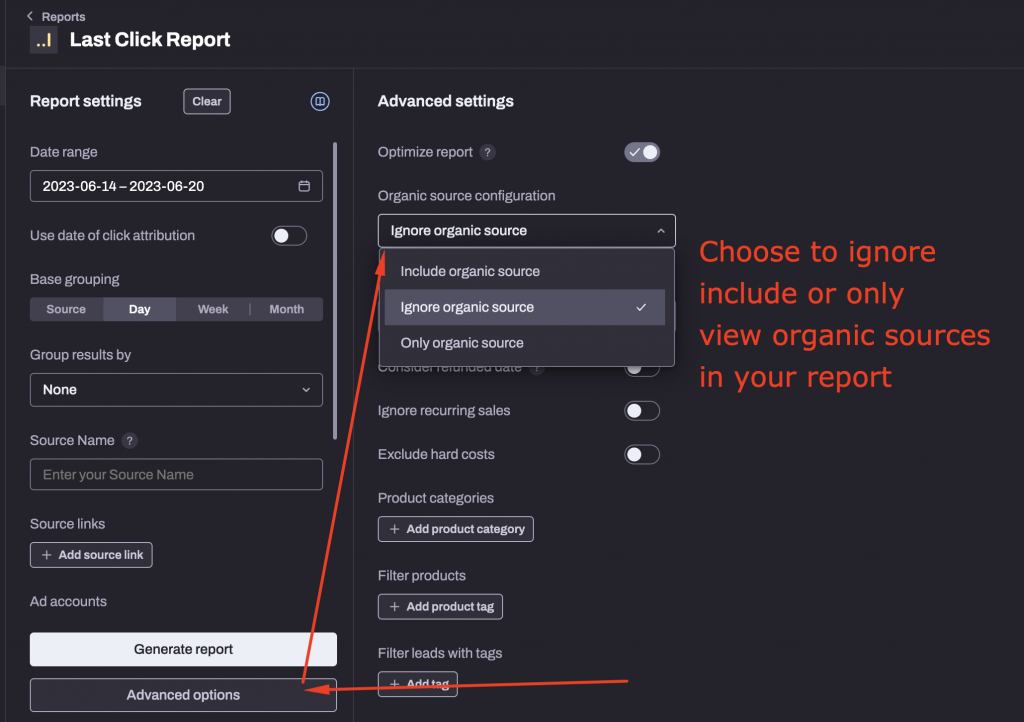
Note that one of our email parameters may trigger this warning if the Facebook pixel is on the same site:

From experience, we have not been able to confirm any cases where this has caused any major issues so far.
Our current interpretation of this is that Facebook are just warning you that they can not use that data, which they never did in the first place. This data is used by Hyros only, so ignoring this should be fine.
HOWEVER please take this as an interpretation only, we can not predict Facebook’s behaviour with certainty. This is your responsibility, and if you want to be safe then there are 3 solutions for you to choose from:
- Go to your pixel settings and under “automatic advanced matching” open up the advanced options and toggle off any information that has been flagged by Facebook (this can negatively effect your event match quality):
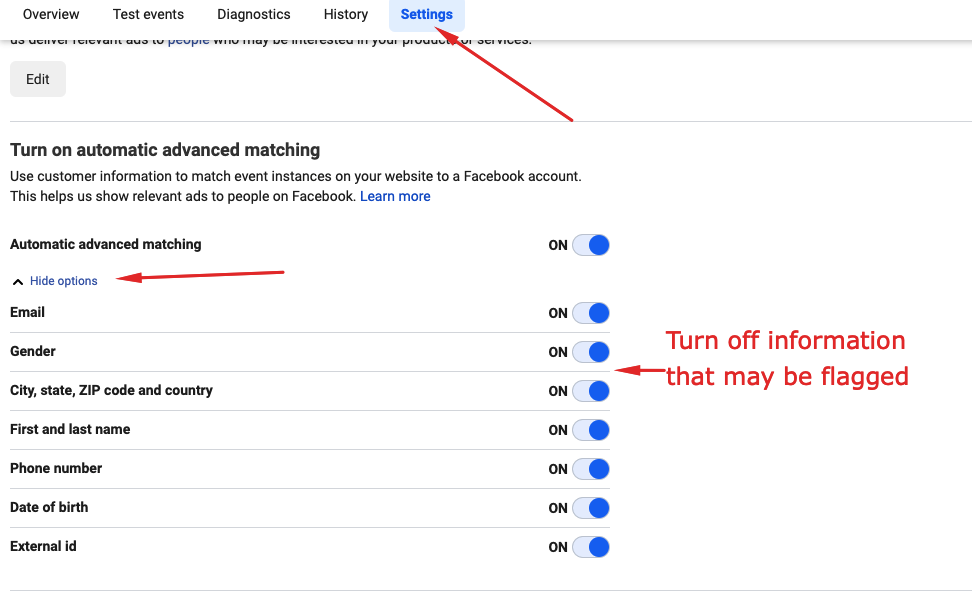
- Remove the parameter causing the issue. For example, if it is the “he=” parameter, then remove that parameter from your email links and just use the “el=email” parameter or UTMs to track your sources.
Please see the explanation on what the “he” parameter does under the “How does tracking work?” dropdown for more information. - Remove the pixel from your site.